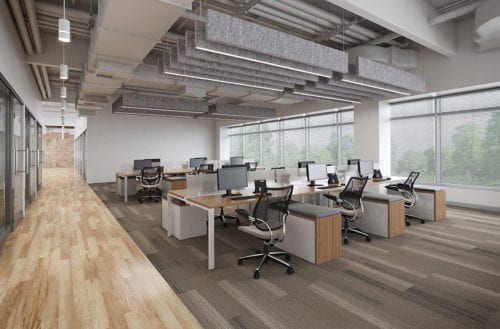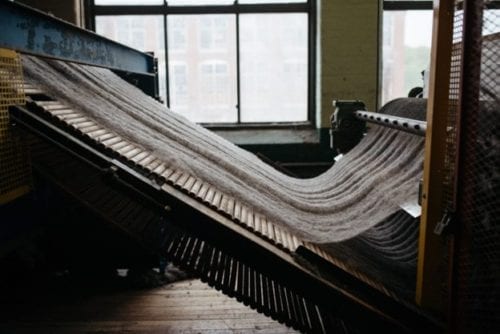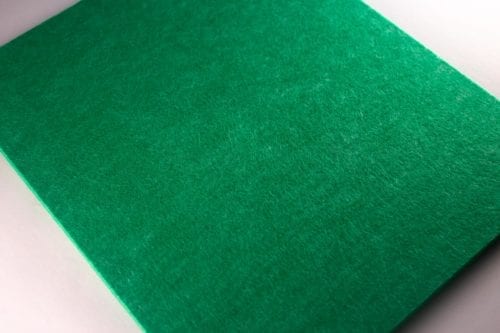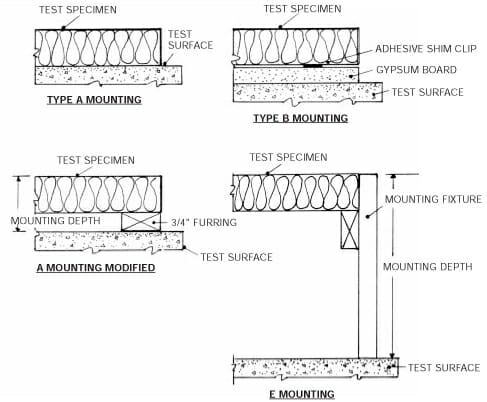How Are Polyester Acoustic Panels Made & How To Identify Quality Panels

One of the hottest trends in office furniture and interior design is the rise of polyester (PET) acoustic panels. The use of these panels is growing significantly in markets such as construction, retrofits of existing offices, and other commercial and public spaces.
Over the past 3 years, polyester acoustic panels have seen a massive upsurge in demand. This is due, primarily, to their flexibility in color, form, and ease of use when compared to traditional fiberglass acoustic panels. Fiberglass panels can cause irritation and air contamination due to the chemicals they sometimes contain in their binders.
The industry has quickly adopted these panels whether being used as desk dividers, light fixtures, hanging sound baffles, wall-mounted art, or any number of other uses. But what exactly are polyester acoustic panels? How are they made? What should you look for in a quality product or a vendor? We answer all of these questions and more.
How are polyester acoustic panels made?
To understand the challenges that arise on the quality front, you first have to understand how polyester acoustic panels are made.
1. Define the desired outcome
The process to create a finished acoustical panel starts with determining what characteristics we want the finished panel to have. We can affect acoustical curves (NRC), stiffness, surface texture, or color by changing the fiber material or size, product density or thickness, or manufacturing processing of our finished panels. Each variable lets us dial in the ideal finished characteristics. Our standard Poly-Sonic panels are comprised of recycled polyester fiber and special lower melting point polyester fiber.
2. Manufacture the needle punch felt
Next, we start the manufacturing process. Every polyester acoustic panel starts out life as a nonwoven, needle punch felt. This felt is similar to the felt kids make craft projects out of, but much thicker and denser!
We begin by taking raw fiber and turning it into a “web”. We then build density and surface characteristics by adding batts and needling the material together. The repeated needling that the felt receives is one of the keys to creating a stiff panel while maintaining a super smooth-surfaced panel. From this process, we create a “master roll” of felt. For a more detailed description of how needle punch felt is made, check out this link.

3. Heat-setting
The felt moves to the heat-setting machinery following the creation of the master roll. This could be a mold for 3d shaped panels or some form of flat pressing system. This process changes the material from a roll of flexible felt to a stiff polyester acoustic panel.
When heat hits the polyester fibers, they melt and flow like a liquid thermo-plastic. Fibers like these are specially designed to have a low melt point. As this material cools, it turns back into plastic but is now spread throughout the felt, attached to all the fiber around it, and (with the assistance of the needling) creates the stiffness of the finished acoustic panel.
The heat-setting process is one of the most difficult to perfect. This is because the material will shrink three-dimensionally while being heated. And any imperfections in needling will create very obvious surface defects.
4. Cutting
The final manufacturing step is to cut the panels to their final dimensions or shape. Most architects and interior designers need tolerances of +/- 1/8th of an inch. Some elaborate designs require tighter than +/-1/16th of an inch. This would normally favor a die-cutting process but in many cases, the variety of shapes and rectangular dimensions needed would make this cost-prohibitive. Only with extremely precise cutting tools such as CNC machinery using oscillating blades, lasers, or waterjet cutting can near-perfect acoustical panels be cut every time.
What quality attributes should you look for when assessing polyester acoustic panels?
There are several factors to consider when determining whether a polyester acoustic panel is of top quality.
Uniformity
Is the first panel just like all the others and, also as important, is each individual polyester acoustic panel consistent within itself?
One of the key giveaways of an inconsistent process is that one panel does not look like the next. When dealing with large-scale projects, even minor consistency problems can stand out when looking from panel to panel or from one section of a panel to another. Unfortunately, due to the nature of the panel manufacturing process, it is impossible for panels to be exactly identical, but the closer they are, the better.
Blending
The distribution of colors in a panel is one of the first things to stand out. Many panels have a “heathered” look to them. This comes from blending two or more colors of fiber together. Do you see clumps color? Or is everything evenly spread out?

Thickness
Another one of the most noticeable attributes comes when comparing the thickness of different panels. When placing panels next to each other on a wall or in a line of desk dividers, check to see if the panels are of different thicknesses.
The thickness of each acoustic panel is one of the major drivers of its acoustical absorption capability. Thicker is better!
Stiffness
Many applications for acoustic panels, such as desk dividers, require very stiff panels. Make sure to check if the panels stiff enough for your use. Is each panel consistently stiff? This could be from one corner to another or from one surface side to another.
Many manufacturers struggle with getting enough heat all the way through the panels to fully activate the low-melt fiber. This is especially true on thicker panels. Often, an inferior panel will have a softer center and two harder surface faces when you look at the panel from the side. When this happens, the panels tend to not hold mounting bolts or hardware as well and also tend to collapse and bend easily when held from only one side. This usually destroys the panel by creating unwanted wrinkles on the surface.
Acoustic Certifications (ASTM C423)
Polyester acoustic panels have many uses, but as the name implies, “acoustic” tends to be the key attribute for many applications. All panels should have an NRC value, and most “standard” specifications will.
Where this gets tricky is when comparing panels from different vendors that look the same but have vastly different ASTM C423 results. Logic says that the higher number is better, right? Well, not quite…
There are different variations of the ASTM C423 test. These range from “A” mount where the acoustic panel is placed directly against a cement floor (and will have a lower NRC number) to “E Mount” where the panel is suspended several inches in the air (and the NRC number will be higher). It isn’t wrong for a vendor to use “E” mount test data, but make sure you compare apples to apples when comparing!

As a secondary note for ASTM C423 testing that produces an NRC value, keep in mind that NRC is an average of performance at different frequencies. If you have specific acoustical profiles or sound frequencies that you need to target, then make sure you look at the charts to compare performance at your specific frequency.

The acoustical curve of BIT’s Poly-Sonic 45 (9mm thick) acoustical panel using ASTM 423 A-mount. Note the different absorption coefficients at different frequencies. NRC: 0.30
Flame and Smoke Certifications (ASTM E84)
The ASTM E84 certification uses a combination of a flame spread and smoke generation test. It is one of the most important certifications for applications that are considered “building materials”. Depending on your application, you may not require this certification, but most suppliers will have their acoustic panels tested to this specification.
There are several results possible all resulting from the flame spread portion of the test. The generally accepted standard is “Class A” and, if your application requires this test then be sure to look for this.
One word of caution here, not all ASTM E84 tests or testing labs are equal. Many of our customers are wary of using unknown foreign laboratory results for good reason. We have heard some horror stories about vendor-provided laboratory results looking good but when independently tested their panels fail miserably.
Due to the moral values and legal penalties involved in failing this test, most of our customers will conduct their own testing using a US certified lab. We recommend that you do the same if you do not personally know the lab that conducted the testing.
What to look for in a vendor
Now that we have reviewed the critical parts of a quality panel, it is easier to identify what to look for (and what we strive to be!) in a vendor as well. For many customers, being able to provide a consistent, high-quality panel is paramount and all-encompassing. Other normal vendor characteristics to inquire about are minimum order quantities, lead times, and, of course, price. However, there are a few other factors to consider that not every PET acoustic panel vendor can provide.
First is the ability to customize. The market is becoming flooded with 9mm thick panels that look, feel, and perform pretty similarly. But your company might require a distinct acoustical performance curve, custom color options, or different thicknesses. Finding a supplier who can work with you to provide the exact product you need isn’t always needed, but be sure to review your requirements and make sure the company you are working with can handle them.

Another often overlooked aspect of vendor capability is someone you can build a relationship with. Maybe you are in a bind and need an order shipped early. Or you are stuck with a whole truckload of panels after a customer backed out of a deal. Is your vendor willing to take them back no questions asked? Finding a company that you can work with is often worth paying a bit more when they save you headaches down the road!
Bouckaert Industrial Textiles tries to meet all of our customer’s needs from minimum order quantities, to lead time, to price, to customization and relationship. Our Poly-Sonic polyester acoustic panels are designed and manufactured entirely in the USA.
Have questions or want to learn more about us? Contact us today!


1 Comment
Paul Martineau
Nice tutorial on the process…informative and in plain English.
2 notes: liked your guidance on ASTM testing…and your closing comment on the value of a vendor relationship